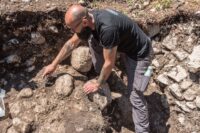 A cremation burial containing bronze jewelry and rare surviving textile fragments has been unearthed from the Early Iron Age (800-550 B.C.) burial ground at Hallstatt, Austria. Grave goods discovered in the burial include spiral discs of bronze wire placed on top of the cremated remains that were likely fibulae (large brooches used to fasten garments), a massive ribbed arm bangle, the blade of a bronze knife with fragments of the wooden handle still attached, a piece of sheet iron from a belt buckle and an animal bone from a food offering.
A cremation burial containing bronze jewelry and rare surviving textile fragments has been unearthed from the Early Iron Age (800-550 B.C.) burial ground at Hallstatt, Austria. Grave goods discovered in the burial include spiral discs of bronze wire placed on top of the cremated remains that were likely fibulae (large brooches used to fasten garments), a massive ribbed arm bangle, the blade of a bronze knife with fragments of the wooden handle still attached, a piece of sheet iron from a belt buckle and an animal bone from a food offering.
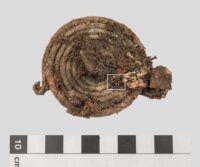
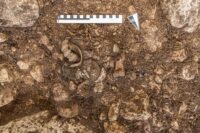 The finds were densely packed into the grave, and it was only when the objects were detached and examined closely that archaeologists recognized the surviving traces of fabric on the undersides of the spiral discs. These might be the first archaeological evidence that textile pouches were used to contain cremated remains for burial. Urns were used in other cemeteries of the period, but are very seldom found in the Hallstatt burial ground. The cremated remains are so compact, however, that archaeologists have long suspected they were buried in organic bags whose fabric or leather had decayed over the millennia.
The finds were densely packed into the grave, and it was only when the objects were detached and examined closely that archaeologists recognized the surviving traces of fabric on the undersides of the spiral discs. These might be the first archaeological evidence that textile pouches were used to contain cremated remains for burial. Urns were used in other cemeteries of the period, but are very seldom found in the Hallstatt burial ground. The cremated remains are so compact, however, that archaeologists have long suspected they were buried in organic bags whose fabric or leather had decayed over the millennia.
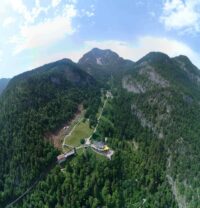 Hallstatt is the site of a salt mine that drew seasonal visitors going back 7,000 years ago to the Neolithic. They attempted to extract the salt using picks made of deer antlers and stone axes, but systematic mining of the salt began in the 16th century B.C. Three prehistoric mines have been identified amidst the warren of subterranean tunnels, one Bronze age, one from the Early Iron Age, one from the Late Iron Age.
Hallstatt is the site of a salt mine that drew seasonal visitors going back 7,000 years ago to the Neolithic. They attempted to extract the salt using picks made of deer antlers and stone axes, but systematic mining of the salt began in the 16th century B.C. Three prehistoric mines have been identified amidst the warren of subterranean tunnels, one Bronze age, one from the Early Iron Age, one from the Late Iron Age.
High in the Salzberg Valley is a burial ground connected to the mine that is one of the most important prehistoric burial grounds in Europe. The burial ground was in use from 850 B.C. through about 350 B.C. Luxury goods imported from all over the known world were buried with the 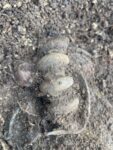 dead, a testament to the great wealth and far-reaching trade relations generated by the mining of salt at Hallstatt. The variety, quality and distinctiveness of the artifacts found there prompted researchers to use “Hallstatt” as the name of a culture and an entire period of European prehistory (8th-5th centuries B.C.).
dead, a testament to the great wealth and far-reaching trade relations generated by the mining of salt at Hallstatt. The variety, quality and distinctiveness of the artifacts found there prompted researchers to use “Hallstatt” as the name of a culture and an entire period of European prehistory (8th-5th centuries B.C.).
The Iron Age burial ground was first discovered in 1846 by Johann Georg Ramsauer, the director of the salt mine who had worked there since he was a 13-year-old apprentice and rose through the ranks to become Bergmeister (mining master) by the age of 36. Then, after discovering the first grave in a gravel pit, with zero training or education he transformed himself into a meticulous accidental archaeologist. From 1846 until 1863, he directed the excavations of the Hallstatt cemetery, and documented everything he found with incredibly detailed watercolors.
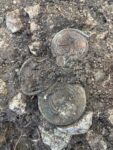 In 17 years of excavations, Ramsauer and his crew unearthed 980 graves containing almost 20,000 objects. He thought they had found all that there was to be found, but new graves were discovered in the 1930s and the Natural History Museum has found many more since it began annual excavations of the burial ground in 1992. As of now, more than 1,500 graves have been unearthed and documented, and the discovery of the latest grave suggests the burial ground is even larger than previously realized. Archaeologists estimate there may be another 4,000-5,000 unexplored graves at the site.
In 17 years of excavations, Ramsauer and his crew unearthed 980 graves containing almost 20,000 objects. He thought they had found all that there was to be found, but new graves were discovered in the 1930s and the Natural History Museum has found many more since it began annual excavations of the burial ground in 1992. As of now, more than 1,500 graves have been unearthed and documented, and the discovery of the latest grave suggests the burial ground is even larger than previously realized. Archaeologists estimate there may be another 4,000-5,000 unexplored graves at the site.
Not that the “great wealth and far-reaching trade relations” were not necessarily generated by the mining of the salt itself at Hallstatt, but particularly also by processing meat with it on an industrial scale.
Often, place names are an indicator –from ᾱ̔λῐ́ζω, ‘hālízō’ = “I do salt”, i.e. pork in this case– cf.: Hallstatt, Schwäbisch Hall, Hallein, Bad Reichenhall (etc.). Also, there are hints that the pigs were brought from wider areas.
During the 4th century BC, unfortunately, the production must have stopped, presumably due to a mining accident. However, in 1734, one of the extremely well cured miners was found.
From the homepage of the ‘Naturhistorisches Museum Wien’ (NHM) on “Bronze Age meat processing around the mine in Hallstatt”.
——
“Modern analyses have revealed that the Salzbergtal valley around Hallstatt was home to a meat processing industry during the Bronze Age. It is likely that selected pieces of meat, in particular pork, were transported into the valley for processing. Ethno-archaeological researchers have been able to determine similarities between the cuts of meat used in prehistoric times and those still used in the Alps today. It appears that the meat was cured in large vats. Experiments have shown that the mines in Hallstatt would have provided excellent conditions for cured meat to mature.
## Dissection techniques for slaughtered animals
Archaeo-zoological analyses have revealed that a special technique very different from those commonly used today was employed in prehistoric times to dissect animals. This technique is still employed in a few regions of the Eastern Alps: in the production of the famous Gailtal bacon, the pig is also deboned dorsally with the ribs and the entrails, from the tail to the upper skull removed. The two boneless halves thus obtained can then be salted and smoked. It looks as if, in order to facilitate packing and transportation, ready-prepared, partially deboned carcasses were taken up the mountain at Hallstatt, with the lower jaws plausibly serving as a sort of handle.
## Meat curing in wooden cabins
The dimensions of the curing troughs, and the large number of pig bones, indicate that large quantities of pork were salted, some 150 or 200 carcasses per basin at a time – and we know of eight such basins! The salt required came from the mine; it was, however, not the high-quality, pure rock salt, but the lower-grade by-product known as Haselgebirge, a mixture of salt, clay and anhydrite.
To ensure proper functioning, the timber trough had to be tightly waterproofed, and this is why a daub of grey mountain loam packed deep into the walls and over the bottom. Experiments have shown that sufficient salt penetration is achieved after ten days of brine curing and that the meat is at that point conserved.
## Maturing of meat in the mines
Further curing could have occurred in the mine galleries. With the salt-saturated air full of smoke from the many fir tapers, a strong draught in the ventilation shafts, an average temperature of 7° C, and 60% humidity there was an ideal microclimate for the further improvement and maturation of the salted hams. The finds suggest that large quantities of ham and bacon, far beyond domestic requirements, were produced, and therefore traded.
(Barth, F. E. – Reschreiter, H. – Kowarik, K. – Loew, C.)”
——